
Bouvier des Flandres:
Memoirs of an Advocate
Clk to enlarge
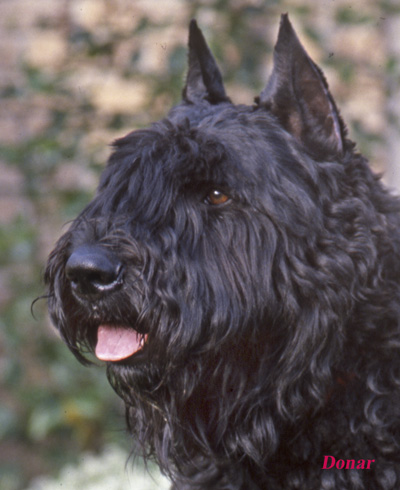
A timeless Bouvier icon: Ria Klep's Donar.
Jim Engel
This is a variant of the preface, an overview, of a much larger in progress work of the same name, being disseminated now because the time has come to speak out.
Over the past two decades I have remained aloof from Bouvier des Flandres affairs; after so many years of advocacy my deepest and most passionate beliefs and principles had come to be irreconcilably estranged not only from the conformation and companion elements, in Europe as well as America, but also from the mainstream of the North American working movement. My personal crusade had come to an end in failure.
In the intervening years I have abstained from direct comment or interference, left working Bouvier affairs in the hands of those who had prevailed, stood despondently at a distance as my expectations of decline, debasement and leadership based on personal agenda and advantage came to pass, as the breed slipped silently into the abyss. Little remains of this once vibrant movement, the working Bouvier club has long since degenerated into an empty shell, a commercial place holder in an increasingly irrelevant AWDF, of no further use even to the third rate commercial kennel which shamelessly wrung out the last vestige of credibility using if for blatant self-promotion. Now that this pathetic saga has run its course the time has come to once more speak out, to address residual issues and finally bring closure, move on once and for all from the role of breed advocate to that of a much more broadly based historian, commentator and critic.
These roles, while sharing much in terms of craft and purpose, have important if subtle distinctions. All of history reflects the world view – the life and times – of the historian, his origins and allegiances. Such is the nature of the human experience. But the obligation to strive for objectivity remains, to present true, complete and balanced history and leave analysis and inference for others or other venues. But this lofty ideal is in reality beyond mere mortals: American history will always present our Revolution as an escape from British tyranny, which it was, while the British will view it as opportunism on the part of ungrateful colonial subjects, which it also was. I have produced a great deal of history, which is left for others to build on, evaluate and critique.
A memoir is a much more personal testament, grounded in firsthand knowledge and personal experience beyond research and scholarship, often and appropriately drawing conclusions and interpreting historical trends as to cause, consequence and future ramifications. This may perhaps bring closure, perspective to an ultimately lost cause, and provide an opportunity for tribute to others—names such as Chastel, Caya, Houttuin and Bowles— who struggled in vain, sometimes over much of a life time, for what will now fade into the mist of history, unfulfilled. But history provides moving examples of unforeseeable destiny, such as Hannibal or Rommel, who ultimately succumbed to the hand of fate. Perhaps there is somehow solace in that epic struggle is by its nature for a noble and arduous cause, perhaps beyond reach, undertaken in the face, even likelihood, of failure. Nobility ultimately is in the courage and tenacity to strive against the odds rather than the verdict of fate, triumph and tragedy being but opposite sides of the same coin.
Over the later 1980s and early 90s personal estrangement had emerged, almost imperceptibly in the beginning but then with inevitability as my beliefs evolved in response to ongoing experience and expanding historical perspective. In the earliest years, commencing in the very late 1970s, the conventional wisdom had been that the Bouvier community— small, deeply fragmented, fragile— needed to be inclusive, to seek common ground among all constituents. The inevitable naiveté of the novice lacking the guidance and example of a previous generation and more senior mentors led to buy in, even to an article entitled One Bouvier asserting that somehow we could have it all, incorporate the companion and show dog elements, the obedience and rally enthusiasts. This turned out to be dead wrong, and it was an irrecoverable error, a turn down an ultimately fatal fork in the road.
Extensive time in Europe, primarily the Netherlands and Belgium, in this era and diligent research had led to the realization that a serious working breed must be focused exclusively on its defining role—in this instance dual purpose police and military service—as this is and must be the existential reason for a breed to exist. The hunting dog must hunt, the coursing dog must endure and the patrol dog must be ever vigilant, prepared to engage. All other considerations are distractions, must be secondary, subservient.
In particular the von Stephanitz principle, that form must follow function, dictates that breeding stock must be selected according to demonstrable real world working potential rather than on the basis of conformation fashion and appearance. Working criteria must be an expanding expectation of excellence rather than just enough to begrudgingly pass relentlessly diminishing expectations, as can be observed as Schutzhund devolves into IPO. Meanwhile the spirit of the KNPV and Belgian Ring programs was casting the Malinois, in eclipse for most of a century, into an increasingly preeminent role on the world stage as our Bouvier faded into obscurity as a working presence, his promise unfulfilled as his advocates faltered.
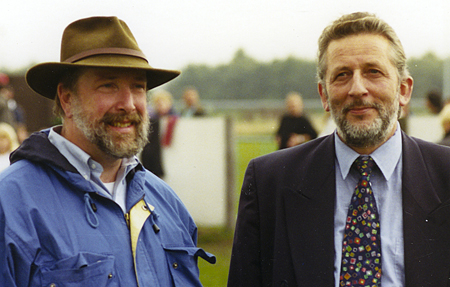
Jim Engel & Peter van Leeuwen, president of the Netherlands Bouvier Club,
about 1991.
So much water under the bridge. Clk photo to enlarge
In the later 1980s I had been instrumental in founding the North American Working Bouvier Association, primarily in conjunction with Erik Houttuin. In retrospect this was fatally flawed, preordained to failure because the desire for immediate presence and popularity led to compromise on fundamental principles and the inclusion of a large contingent of members with no real skin in the game, no inherent commitment to the protective heritage. The shadow of show and pet influence tended to cause potentially serious newcomers to move on to other breeds perceived as more serious. Within a decade these elements had become predominant, and emasculated the association and the movement, leading to my estrangement.
In 1985, with the internet still far in the future and the incipient American Schutzhund and Ring Sport movements in their infancy, most of us had an unshakable faith in the European canine establishments. Looking back it seems like a distant alien wonderland, but the distinction between working and show lines, so ubiquitous today, was not then part of our vernacular; most of us actually did believe that the Schutzhund titles being handed out by the SV in Germany meant that every young German Shepherd was a credible potential police service candidate, and that while the Doberman or Bouvier clubs might not actually require a working title it was inconceivable that they could condone breeding that did not adhere to this spirt, that these were legitimate working breeds in the care of committed advocates, trainers and breeders serious about character. Little did we know.
The reality that we were loath to accept was that the FCI affiliated breed clubs, most specifically including the SV, were no more serious about or supportive of the working culture than the American AKC clubs we were so desperately trying to circumvent, that the hard core working people were predominantly in other entities such as the KNPV in the Netherlands or the NVBK in Belgium, which had broken away from FCI affiliation in 1963 to chart their own course. In Germany the committed working advocates, such as Helmut Raiser, were increasingly estranged from the SV hierarchy. Our idols actually did have feet of clay.
In the early 1980s American Bouvier focus was primarily on Belgium and to a lesser extent France. Most Americans were unaware of a Dutch culture that was equally deep, and incorporated most of the best of the working stock in the KNPV lines, which were, however, culturally and genetically increasingly disjoint from the Dutch show lines. The Dutch Raad van Beheer establishment itself was the least overtly supportive of work, although this was more a matter of style rather than substance in that they were more or less dismissive or oblivious while the Belgians and particularly the French habitually spouted shrill, incessant nonsense about the character of the Bouvier des Flandres, mostly in promotion of their sham character tests, while the credibility of the lines incessantly declined. There were notable exceptions, such as Gerard Gelineau whose du Clos des Jeunes Plantes Bouviers were serious French Ring contenders in the late 1970s, but he himself was increasingly estranged from the French Bouvier establishment.
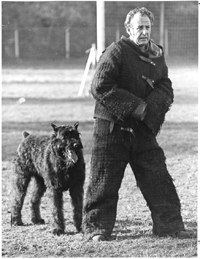
Duko v Mereveld Clk to enlarge
Through the middle 1980s Americans were generally oblivious to the existence of this Dutch Bouvier heritage, often aware of it only through disdainful and derisive commentary of haughty Frenchmen who had been to Holland or seen a show. Beginning in the mid-1980s however the Dutch show breeders had to a large extent abandoned their own history and based on Belgian imports, particularly the de la Thudinie lines of Justin Chastel, created a surge in popularity that overshadowed the Belgians and became predominant in the American show ring, only to wither as the cropping and docking bans tightened in Europe and the incidence of genetic defects such as blindness and heart defects, consequences of very tight breeding in the fashionable show lines, began to proliferate leading to the collapse of the bubble.
Happenstance of birth date, place and circumstance often casts a long shadow. The Bouvier des Flandres emerged in the Flemish region of Belgium, culturally and linguistically seamlessly aligned with the Dutch to the north, also the people and culture from which had emerged the Belgian Shepherd, especially the Malinois, a generation earlier. Being the second child in a very small and obscure family was not an auspicious beginning, and both of these noble breeds, at the epicenter of two German atrocities in a generation, struggled for survival in the early years. Both were involved in the foundation of the first formal metropolitan police force in Ghent in 1900, but this program and heritage was obliterated by the German occupation in 1914, casting the incipient Belgian working culture into eclipse for several subsequent generations.
The divisive and ultimately lethal issue within the American working Bouvier movement was the proposed adaptation of some variant of the temperament or character tests promulgated and promoted by the Belgian and especially the French national clubs. Many believed, or for ulterior motives pretended to believe, that following this European precedent was the obvious way forward, but having been to Europe and seen the farce play out in person I knew full well that far from being the panacea these tests were portrayed as they were in fact a fraud perpetrated by the Belgian and French show breeders, a mythology supporting contrivance providing cover for increasingly docile and passive show lines. Primary push was coming from would be American "working" breeders unwilling or unable to train seriously, who encouraged, aided and abetted companion owners and show breeders for whom certification sans personal effort or training was a compelling myth, a false fulfillment of fantasies of the noble protectors of the Flemish plain. Ultimately these dilatants prevailed, emasculating the association, the movement and the breed in the later 1990s.
As the twenty first century commenced those who had prevailed were gleeful, triumphant, had pushed out the founders, grasped control of the working association, were enthusiastically pursuing their diverse personal agendas. They declared themselves evaluators and run their pathetic temperament tests, put on their pseudo herding trials, ran their carting events, played with their dogs. They quarreled among themselves and regional cabals broke off to run their own self-promoting events, then evaporating, leaving nothing behind. They took full advantage of the power to run working championships as virtually private side yard commercial promotions, until it became so pathetic that even they were too ashamed to go on.
But what is their legacy? What had become of our Bouvier des Flandres on their watch? They seized and flaunted custody of the heritage, who among them will now step forward and take personal responsibility for the fate of the Bouvier des Flanders in American working venues, on trial fields? Must I call out the names? Perhaps in good time.
Had this collapse been merely a transient American episode, had there remained robust European lines and an ongoing training culture then it would not have mattered in the long run, for there would have been another day, the possibility of resurgence. Transplanting a working culture to virgin soil is an incredibly daunting process; there were several ultimately failed German Shepherd efforts beginning in the 1950s and although each in its own way contributed to eventual success efforts such as fledgling DVG affiliated clubs in the early 1970s and the North American Schutzhund Association (NASA) faltered and then faded away after early promise, but were invaluable precursors to later success.
But such a reservoir was never there for the Bouvier, although there were over the years many passionate individual trainers in Belgium and France such as Eddy ten Grootenhuysen in the Belgian Ring. But there was in reality no ongoing program, no sustained culture and no effective support from the national clubs. There were for some extenuating circumstances; in the 1950s the Bouvier had been on the brink of extinction in Belgium, with five consecutive years of fewer than one hundred registrations, had it not been for the heroic struggle of Justin Chastel and Felix Verbanck the breed would almost certainly have perished at that time.
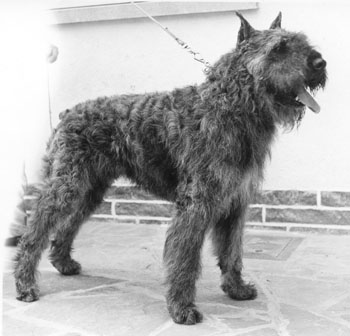
Tapin de la Thudinie, Clk to enlarge
In the Low countries, principally the Netherlands and Belgium, and also in France working trials had historically featured the full body suit rather than limiting the bite to a padded arm as in the German Schutzhund program. The royal Dutch police program, the KNPV, had provided the indigenous venue but beginning in the later 1970s national programs similar to the German Schutzhund began to emerge in the rest of Europe, eventually evolving into IPO under FCI auspices. Thus the foundation Bouvier working lines in the Netherlands were in the KNPV program, but they were never especially numerous with a peak of 30 certificates in 1975 and never more than 17 after 1980. The widespread availability of affordable Schutzhund titled German Shepherds for competition and breeding, as a kick start to an American culture, simply did not exist for the Bouvier or any other breed; many Americans without a strong breed commitment gravitated to what was there, the German Shepherd in the early days and then later the Malinois, today everybody's second choice as a working breed.
Breed success arises hand in hand with rising prosperity, cohesion and national pride in a land of origin as in the English Collies and Airedales and the protective heritage Shepherds, Rottweilers and Doberman Pinschers of Germany. The Bouvier des Flandres, coming on the scene a generation after that other Flemish working dog, the Malinois, from the beginning was encumbered by a lack of cohesive, effective leadership in a coherent and unified homeland. Belgium is simply not, never has been and likely never will be a nation in any fundamental sense, is deeply divided into two linguistic and cultural communities perpetually antagonistic and hostile. Belgian canine organizations were from the beginning dominated by the culturally French Belgians because they had inherited from French occupation control of national legal, political and cultural affairs and all major publications, and thus were perpetually estranged from an historically repressed but later prospering Flemish community. It is of course true that the Malinois does prosper, but for nearly three generations, until the 1960s, he endured by a paper thin margin, perpetually one setback away from oblivion, and because of increasingly prosperous populations on Dutch and later French trial fields.
The French provided little international support or leadership, have historically been outsiders remote from the protective heritage working dog culture. The French breeds—the Picardy Shepherds, Beaucerons and Briards—withered on the vine, were always much less popular than German dogs such as the Rottweiler. The French Ring Sport thus historically always featured foreign breeds, the German Shepherd through the 1970s and then the Flemish Malinois. Although there were some notable individual efforts, Bouvier des Flanders participation was always sporadic and at a very low level, with virtually no effective support from the national club or the mainstream breeding community.
While it is intensely painful—an abiding, haunting personal sense of failure—ultimately it must be acknowledged: the robust, virile Bouvier des Flandres I came to love and advocate so many years ago is now receding into history, leaving only a remnant, a shadow as a reminder of the legacy of the founders. The decline in numbers is secondary, it is the loss of the robust, quick, agile physique, the alert and intensive bearing, the working willingness, the aggression, the aggregate decline in all of these diverse components of what we have come to know as working character, gone. That other breeds, each with their own passionate advocates, are in similar decline is not a consolation; even the German Shepherd, though his advocates are largely in denial, walks on the edge of the abyss.
Moving On
Time goes on, and subsequent to the collapse of the working Bouvier initiative my personal focus shifted to other areas such as wood working and photography in an ultimately futile attempt to leave public canine affairs behind as a melancholy but closed chapter in my life. Senior office in the Bouvier club and AWDF in the early 1990s had necessitated a sharp reduction in public commentary relative to my Dog Sports days; formal obligations to working Bouvier affairs necessitated a much lower public profile and a cooperative relationship with national entities such as the AWDF and USCA and the European Bouvier establishment. As I relinquished office in the late 1990s this already low profile was to persist for most of a decade.
Clk to enlarge
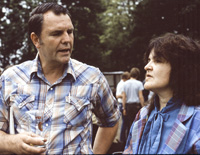
Erik Houttuin and Annie Verheyen,
The Netherlands, later 1980s
In spite of personal disillusionment an unquenchable spark of idealism still did burn. In an era of cynicism, money, commercialism and self-service the idealist is an anomaly, never taken quite seriously, regarded as one with a slick cover for an unperceivable selfish agenda, or simply a fool, not quite clever enough to navigate the real world. Yet even when my personal advocacy slipped beyond reach and illusions were stripped away an irrepressible core of idealism did remain; and the realization that so many on my pedestal were in the end revealed as shallow, grasping and venal cut deep. The spark became anger, and I began to write.
It is said that the bigger they are the harder they fall, and the empire launched by Max von Stephanitz, that of the German Shepherd, was through a tumultuous century, two world wars and the great depression, spectacularly prosperous. Throughout the world, in all of Europe, the Americas and even in prewar Japan, where there were strong national clubs even then, the words German Shepherd and police dog became virtually synonymous. This noble breed became for generations the most popular in Germany and also for many years in America and much of the rest of the world.
And yet they tremble even if they do not yet fall. The empire stands, but there is a smoldering core of greed eroding the center. Since the middle 1990s German puppy registrations have fallen by two thirds, the Malinois is emerging as the predominant police and military dog worldwide, the creatures in SV show rings have become bizarre slope backed monstrosities, banana backs, and widespread crippling back problems in young working dogs are reminiscent of the emergence of hip dysplasia two generations ago. Just as the Soviet Union was perceived as an unshakable monolith—too powerful, vast and well entrenched to falter—and then collapsed precipitously in a matter of months the collapse of the SV empire no longer seems beyond the realm of possibility. There is a silver lining—a steadfast corps of hard line breeders and trainers who have stayed the course through every adversity, perhaps to rise from the ashes should the collapse materialize.
The American Schutzhund community has from the beginning found enormous difficulty in wrapping its mind around this inconceivable but inexorably emerging reality, that SV power has spawned endemic corruption, the division of the foundation breed into two for the love of money, that the show lines have become a new and pernicious breed of their own, devoid of the strong working character and robust, athletic physique that was the foundation, the legacy of von Stephanitz and his associates.
Even in the early years as we began to perceive the venality of the AKC we could dismiss it as an American aberration, an unfortunate legacy of British roots; confident that redemption, a remedy, was at hand in Germany, the mother land of so much of this culture. Yet even today USCA finds itself shamelessly pandering these show line monstrosities, denying the heritage, speaking out of both sides of the mouth. This foundation of hypocrisy must be repudiated and rectified in order for USCA to emerge as an honest pillar of the American working dog community. Time is of the essence, this blatant hypocrisy will inexorably consume the soul, the integrity, until ultimately nothing will remain other than a shell as empty as that of the SV itself.
Prognostication
Since our Bouvier book was published a quarter century ago much has come to pass, bringing forth among many other issues the question of whether the printed page remains the most effective agent of change and means for the preservation of history, knowledge and culture. The internet and other transformative technical innovations in communication and travel have recast the world, accelerating change and extending cultural reach, democratizing the dissemination of knowledge and thus influence, weakening elite control by making speech and the press much more truly accessible for the common man yet extending the international reach of grasping entities such as the FCI and the SV. Such things cannot be ignored and offer enormous leverage, they must be harnessed for empowerment in order to preserve and protect our fragile working dog heritage.
Europe is being transformed by the increasing reach and social initiatives of the European Union, bringing forth a common currency, open borders and an assault on centuries of national identity and tradition in the cause of cultural as well as economic union. Those driving the process are increasingly relentless in seeking the legal prerogatives, coercive power and social control to implement and enforce their new order. These oppressive Euro bureaucrats—relentlessly intrusive, socialist leaning and hostile to centuries of nationalism and tradition in the name of unity, are striving to obliterate existing culture through open borders and the consequent imposition of multi culturalism so as to build their utopia upon the ashes.
This has empowered the various left leaning animal rights and pseudo environmentalist elements creating an increasingly hostile environment for the working dog heritage which evolved in the twentieth century under the leadership of men such as Ernest van Wesemael, Conrad Most and Max von Stephanitz. Under FCI auspices these pet and show oriented canine bureaucrats have marched in lock step with the Brussels Eurocrats, relentlessly hostile to real working functionality, pandering to the socialist, environmentalist and animal rights fanatics, blind to the atrocities emerging from their show rings as exemplified by the absurdly narrow Collie heads, the grotesque banana backs of the German Shepherds and the increasingly foreshortened muzzles of the Boxers.
A prime example of this oppressive intrusion into longstanding culture and heritage has been increasingly strident enforcement of European ear cropping and tail docking bans, which have rendered the Doberman in particular a caricature with the appearance and demeanor of an innocuous hound dog and adversely affected the Bouvier and the others, and also many of the hunting breeds, hunting also being among the traditional avocations incompatible with the snow flake agenda. Beyond these direct consequences there is certain to be ongoing pressure for yet more repression, for these people are not about canine or any other sort of welfare; they are about the experience and thrill of power, the gratification of stepping in and gaining control over others, enforcing subservience.
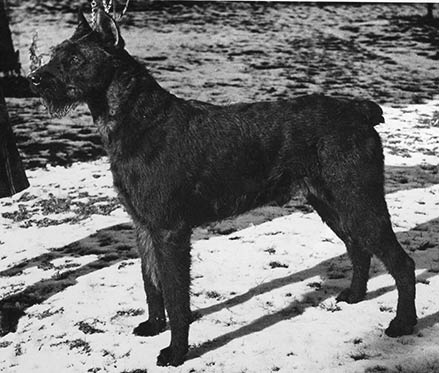
Belco, Clk to enlarge
This said, these bans are not the primary causative factor in the decline of these breeds, for even the German Shepherd is in jeopardy, but to some extent did provide final nails in the coffin. The root cause goes back many years prior, and responsibility must ultimately lay with the national organizations and influential breeders who pandered and paid lip service to the protective heritage but bred and popularized increasingly softer and less intense dogs because it was good business in that even the least dog savvy home was a potential sale, it was where the money is.
Hand in hand with this—the general trend to appeasement of the animal rights and pacifist socialist elements—there has been an ongoing marginalization of protection service, breeding and training, with widespread bans on prong collars, radio controlled correction devices, stick hits in working trials and other similar cultural encroachments. Push back as exemplified by the British exit from the Euro union and the rise of fundamentalist conservative political entities may be reigning in these intrusive, controlling bureaucrats, canine and civil alike, but much of the lost ground is unlikely to be recoverable. Intensive opposition to the 2014 FCI announcement of the removal of the stick hits from the IPO trial on the part of myself and others ultimately forced them to back down, illustrating that we have as much or more to fear from timidity and weakness in of our own leadership as the oppressive tendencies of the civil and FCI authorities; weakness encourages and empowers the bully in every arena of life.
Beginning in the 1990s the purebred dog movement, having emerged in the later 1800s as a novel middle class hobby of collecting all sorts of ribbons, trinkets and empty cups, has faltered precipitously. Beyond the SV collapse mentioned above the AKC decline became so precipitous, down to one third of the 1992 numbers, and embarrassing that they invented a clever and novel solution, in 2011 they just flat out ceased releasing registration statistics, like the child who thinks he becomes invisible when he sticks his head under the blankets.
This decline of the purebred paradigm is both a hazard and an opportunity. Although the world would be a much better place if the decline in the German Shepherd registrations was confined to the degenerate show lines, and much of it is, but disruption and disorder tends to cut a wide swath in terms of expected and particularly unintended consequences. Nevertheless, weakness in the enemy is a trend that every good general aggressively exploits, and the decline of the establishment is an opportunity for growth and expansion of more fundamentally work oriented organizations and infrastructure. An excellent place to start would be USCA reverting to its roots and repudiating the SV show lines, the time may well be upon us when this can be done and made to stick without serious negative repercussions, could indeed put pressure on the SV for desperately needed reform.
In the ideal USCA would revert entirely to its roots, become united in the sense of shedding its German Shepherd identity, originally forced by the SV as the price of access to judges, Schutzhund in the original working trial sense, clubs in the sense of amateur associations rather than professional business entities and become the unifying over all organization making American working dog affairs by and for Americans. The AWDF, DVG and all of the other breed clubs, essentially empty shells, would become entirely superfluous and thus discardable.
In Europe the decline in the FCI national level kennel clubs would for these same reasons provide a window of opportunity, the possibility for the expansion in terms of influence, numbers and power of the truly working entities out of reach of the FCI bureaucrats and the show and pet interests they represent, such as the KNPV and the various ring sport venues. Based on practical performance rather than physical fashion or increasingly stylized and rote IPO trials these lines, primarily Malinois, have provided critical independent venues and support infrastructures.
None of this is going to be easy and many will reflexively recite all of the stock reasons for timidity and inaction, come to the defense of the comfortable status quo. But revolutions do come, often precipitously as in the instances of the fall of Rome, the French Revolution and the collapse of the Soviet Union. We should exert every possible effort to bring on the revolution and shape the canine world that will emerge from the ashes according to our fundamental working values.
In Summary
My passion is and increasingly from the beginning has been the protective heritage, the potential for police and military service, this robust, indefatigable character and these physical attributes of power and agility as the essence of what it means for a dog to be a Bouvier des Flandres. I am told that I am too idealistic, obsessive, impractical, unreasonable, that I must compromise, accept less to preserve more.
I can not, for this is who I am.
Background and Reference:
Informal ResumeThe Bouvier des Flandres
NAWBA in Retrospect
The Fourth Estate
Centauri Story
Glossary
Orginizations and Conflicts
Legacy Lost, the Other Breeds
The Americans
Style and Opinion Sports
Only a Game
How We Play the Game
Commercialization of Schutzhund
The Mother State